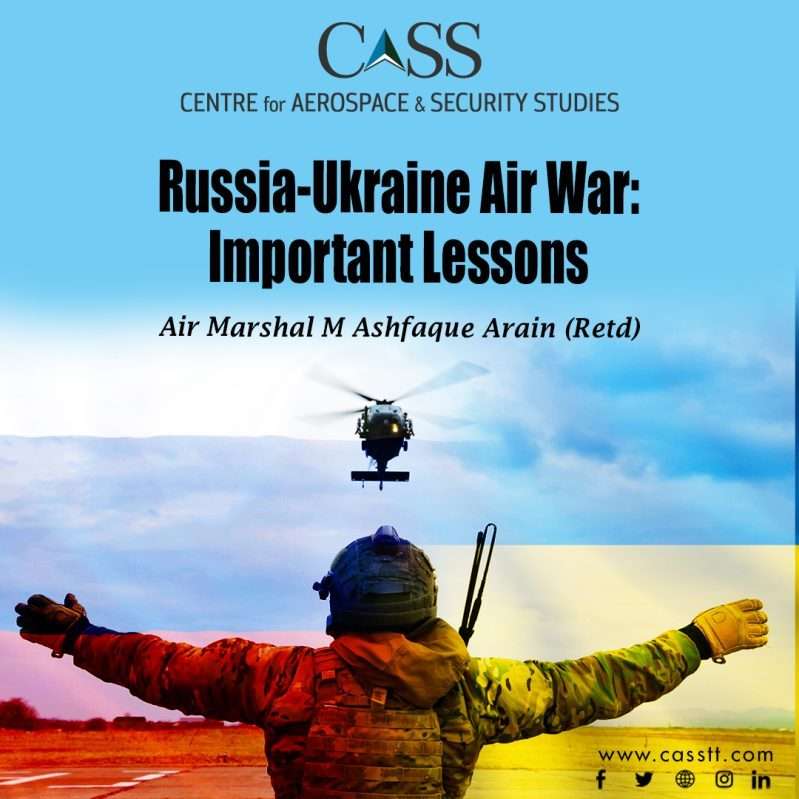The Russia-Ukraine War, which started on 24 February 2022, is an example of a major military power fighting a smaller neighbour, supported by the sole super power and its allies. This provides an unparalleled opportunity to assess the impact of military capabilities and performance of a wide range of modern weapons and technological support. An accurate analysis could help draw valid lessons for application and role of air power in future military conflicts. However, as the conflict is still ongoing, mainstream media only gives the Western perspective and available information is fragmented. Availability of more authentic data may lead to changes in lessons. To asses applicability in other conflicts, like future Indo-Pak conflicts, India’s advantage of having US intelligence support must be given due consideration.
The Russian military operations were preceded by hybrid warfare using disruption through cyber-attacks and destruction with the employment of surface-to-surface and air-to-ground missiles. Russia selectively employed precision guided munitions to destroy military targets such as airfields, ammo dumps, command and control centres, radars and other air defence systems. Some defence industrial complexes were also targeted to damage production capacity. Targets such as Lutsk airfield, just 70 km from the Polish border were attacked to deter military equipment shipments from the West. During the first few hours of the conflict, Russia employed airborne and heliborne operations to capture Antonov airport at a distance of 20 km from Kyiv. However, after successful operations, they failed to form an airhead in the face of shoulder-mounted surface-to-air missile (SAM) threat.
The Russian Air Force succeeded in engaging 75% of static defence sites during the first 48 hours of the war, which suggests that there were no sanctuaries throughout operational depth. The Russian armed forces, however, demonstrated their vulnerability to deception owing to lack of ability to quickly fuse information, as was witnessed during the attack on the Russian naval flagship when the air defences were distracted by UAVs. The air war also highlighted increasing significance of Uncrewed Aerial Systems (UAS) and Counter- UAS (CUAS) in all domains. However, despite their efficacy in providing situational awareness and accurate attacks in highly defended areas, 90% of UAS were lost. Electronic Warfare (EW) emerged as the most effective primary means of countering UAS operations. Despite their ability to create desired effects, precision engagement weapons also demonstrated their vulnerability to enemy EW.
Contrary to Western propaganda, Ukraine mostly employed air power for defensive purposes inside its own territory. This included extensive use of shoulder-fired anti-aircraft weapons making the war appear like urban guerrilla warfare, as in one case the intercepted missile fell on a building. Ukraine’s extensive use of unmanned platforms has given many successes especially against Russian armour columns and sea-based assets. However, these successes could not have been possible for Ukraine to employ its aircraft, missile and UAVs effectively without intelligence information provided by the US and its allies.
An analysis of air operations contradicts Western media reports about Russian inability to gain control of the air, as in such a situation, its ground forces could not have operated deep inside Ukrainian territory. Additionally, despite USD 100 billion dollar military support to Ukraine in ten months and claims of Ukrainian victory, need for more military support clearly indicates Russia’s successes in the war. It may be right to assume that Russia endeavored for air control in the selected areas only.
However, it is also true that despite being 8-10 times larger than the Ukrainian Air Force, Russian Air Force was not utilised to its full potential. This could have been done to limit destruction as Russia possibly intends to control these areas after the war. However, there is a glaring lesson for the Russian Armed Forces which operate on the principle of jointness with land component priorities being paramount. Such an arrangement without the ability to understand employment of all services resulted in suboptimal employment of naval and air forces.
Study of the application of air power in the ongoing Russia-Ukraine war to predict future wars suggests, as discussed earlier,that information warfare remained an intrinsic component of the war operations to build a convincing narrative to shape opinion, legitimise actions and enhance morale of the people as well as armed forces. It also demonstrated that high intensity conflicts require reasonable stockpiles for the envisaged duration of the war. While employment of EW systems ensures success of both, offensive as well as defensive operations, dispersal, camouflage and concealment as well as hardened shelters are extremely important for the protection of assets, especially in the absence of strategic depth. Additionally, airborne operations can only succeed if aircraft, UAS and helicopters can be protected from enemy defences with the help of EW platforms and self-protection jammers. Modern wars require high degree of situational awareness with the help from space and air based assets. Use of Artificial Intelligence will help quick assimilation and distribution of information for decision-making. Employment of long- range precision munitions helps in protecting launch platforms during conduct of offensive operations.
The conflict also demonstrated that joint operations yield best results when planned, practiced and executed jointly supported by joint organisational structures to enhance synergy. Airpower is most effective when it is applied for offensive application to create effect based operations for accelerated achievement of military objectives. Restricted application of airpower fails to achieve desired results. Additionally, as air power is inherently offensive, air defence should also be handled offensively combining offensive and defensive counter air operations as a separate air defence command is likely to fail.
The author is a retired Air Marshal of the PAF who served as Pakistan’s Air Adviser at New Delhi from 2002-2006, presently working as Advisor to CAS on CASS Affairs, and Director Emerging Technologies and International Coordination at the Centre for Aerospace & Security Studies, (CASS), Islamabad, Pakistan. The article was first published in Islamabad Post. He can be reached at [email protected].





